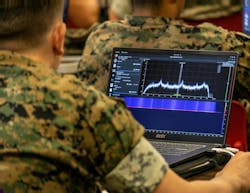Air Force asks industry for digital signal processing and cyber security for signals intelligence (SIGINT)
ROME, N.Y. – U.S. Air Force researchers are asking industry for electronic warfare (EW) algorithms and techniques to enhance signals intelligence (SIGINT) and analytics of existing and emerging enemy systems.
Officials of the Air Force Research Laboratory Information Directorate in Rome, N.Y., issued an advanced research announcement (FA875024S7007) in late September for the Signals Intelligence Focused Technologies for Exploitation and Reporting (SIFTER) project.
SIFTER seeks to mature, prototype, demonstrate, and evaluate algorithms, methodologies, techniques, and capabilities to enable enhanced digital signal processing, exploitation, dissemination, and analytics of existing and emerging enemy systems.
Researchers are interested in onboard processing enhancements of manned and unmanned intelligence, surveillance, and reconnaissance (ISR) systems; high speed signals detection and prosecution; multi-sensor and multi-platform data analytics; and open-systems architecture compliance for demonstration in a realistic setting.
Technology areas include technologies for electronic intelligence; SIGINT analytics; autonomous processing; resilient exploitation; and ways to blend cyber security and signals intelligence.
Electronic intelligence focuses on technologies to detect, identify, and geolocate radar signals. Signals intelligence analytics focuses on technologies to aggregate multi-intelligence data for advanced and pattern-of-life analytics. autonomous processing focuses on technologies for autonomous multi-intelligence architectures. Resilient exploitation focuses on technologies for multi-intelligence architectures. Technologies for Cyber-SIGINT focuses on technologies to address cyber awareness and operations through collaborative SIGINT sensing and analytics.
White papers should focus on using existing and emerging enemy signals and systems; enhance prototype signal processing and exploitation algorithms; using open-systems standards for system interoperability; and using signal processing algorithms.
Related: The next generation in digital sensor and signal processing
Companies interested should email white papers for 2025 projects no later than 21 Oct. 2024 to David Rose at [email protected] and Charles Estrella at [email protected].
Submit white papers for 2026 projects by 25 Sept. 2025; for 2027 projects by 25 Sept. 2026; for 2028 projects by 25 Sept. 2027; and for 2029 projects by 25 Sept. 2028.
Email technology questions to David Rose at [email protected] and Charles Estrella at [email protected], and business questions to Amber Buckley at [email protected]. More information is online at https://sam.gov/opp/77f1bbd8a19640098946378209a7ab97/view.
About the Author
John Keller
Editor-in-Chief
John Keller is the Editor-in-Chief, Military & Aerospace Electronics Magazine--provides extensive coverage and analysis of enabling electronics and optoelectronic technologies in military, space and commercial aviation applications. John has been a member of the Military & Aerospace Electronics staff since 1989 and chief editor since 1995.
